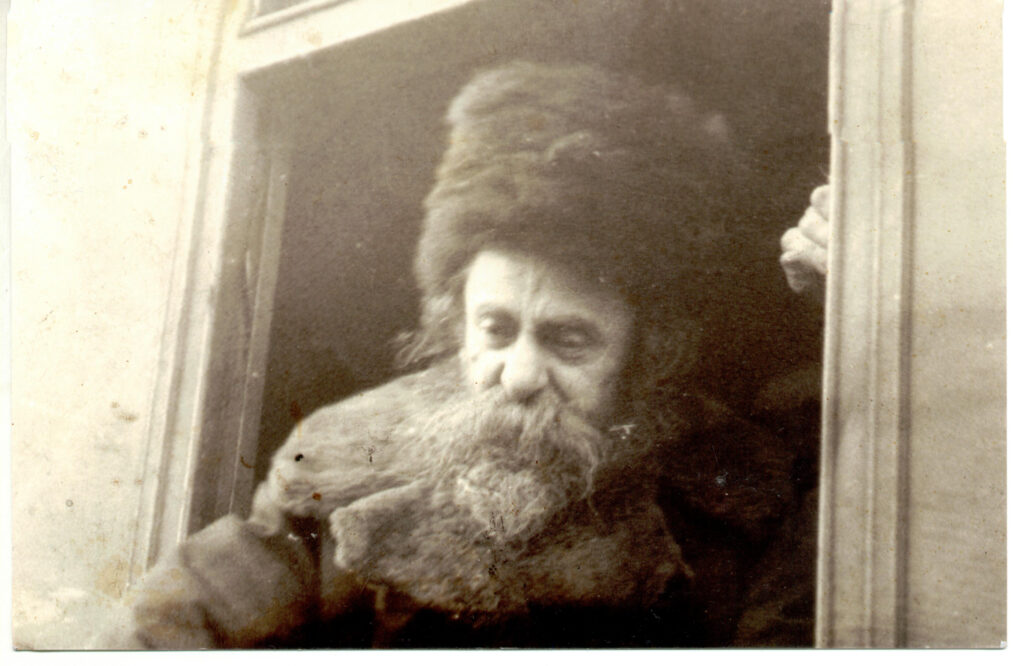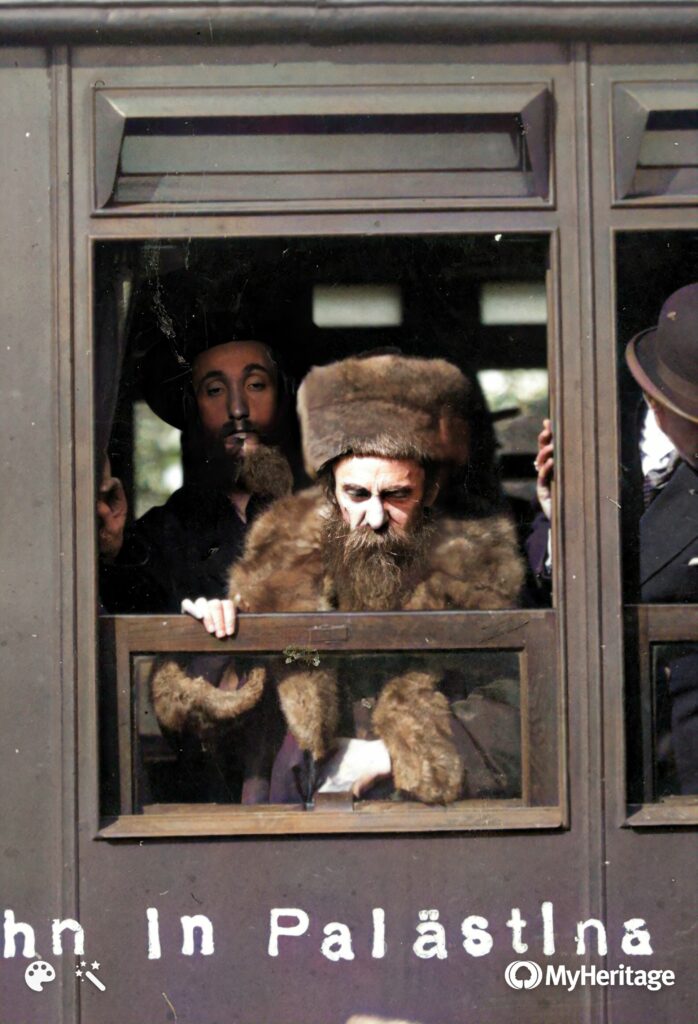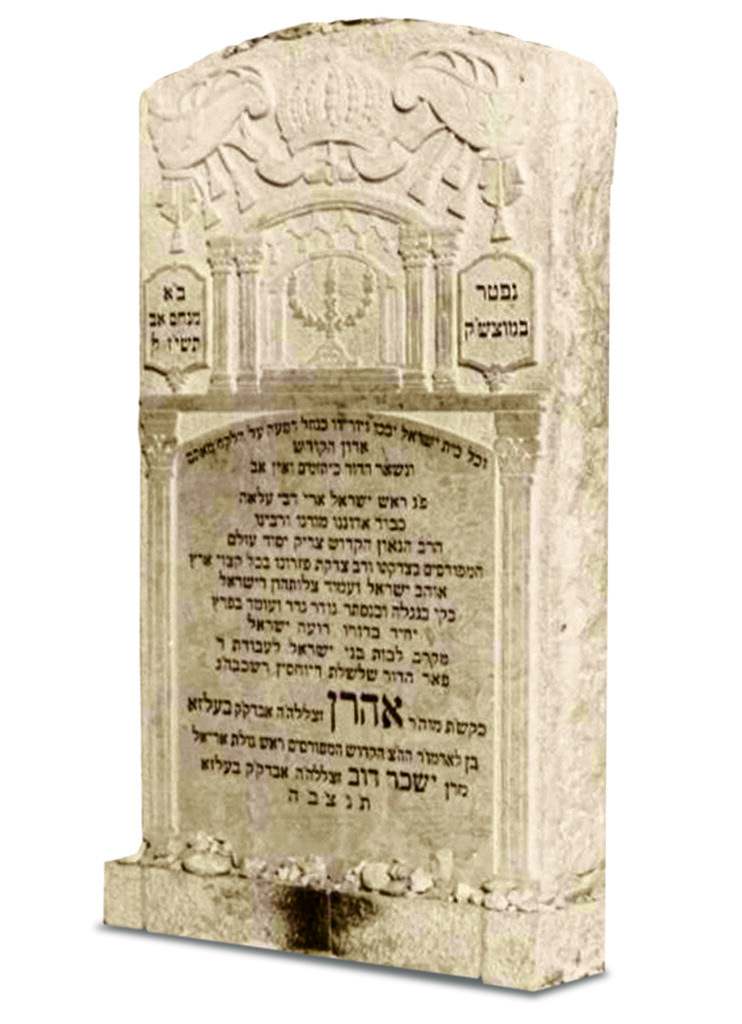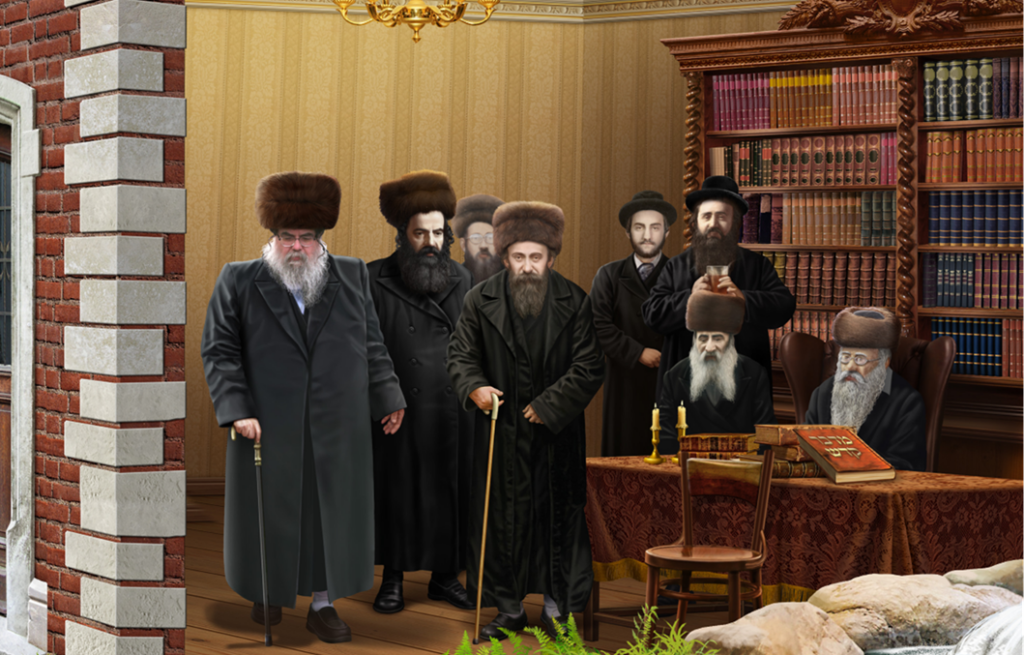

ABOUT – THE HISTORY OF BELZ
Reb Aharon of Belz z”tl
Aharon Kedosh Hashem

Reb Aharon z”l, the Frierdige Rov’s first born son and successor as the fourth Belzer Rov is known by a variety of names or titles ranging from Reb Ahare’le or Reb Aharin’eu to simply Der Belzer Rov Zechrono Levrocha – the Late Belzer Rebbe z”l, but the title Aharon Kedosh Hashem that translates “Aharon [the] holy and G-dly” is by far the most apt and appropriate.
His total and complete dedication to the servitude of His Master while shunning all worldly comforts was phenomenal. From a very young age he seemed to survive on miniscule meals and routine denial of sleep, and as if he was completely detached from his physical being, he would spend hours on end studying and praying. One of his teachers tried to talk him out of his apparently self destructive ways. “Do you know that Chassidus teaches us that one can attain holiness by eating and drinking as well as by fasting? Hashem created human beings in such a way that they need to sustain their bodies with food in order to survive. This proves that it is His divine will that one shall eat, so provided that one eats in moderation, eats only permitted foods and recites the correct blessings before eating etc. one can sanctify His Holy Name while eating”.
“I know” the young boy replied seriously, “however, those who serve Hashem while enjoying His blessings and eating the food He provides us are limiting their servitude to the times of eating. By fasting and restricting the indulgence in food one can serve Hashem at all times!”
A Chassidic Giant
At times it seemed as if his soul had transcended to a higher sphere while his physical body remained seated in the world below!
The history of Chassidus is full of many great spiritual giants, Tzadikim who are lived almost angelic lifestyles; however Reb Aharon was a giant amongst giants. The needs and desires of mere mortals apparently held no meaning for him, as he lived a life of determined detachment from the mundane, and banishment of anything that he deemed coarse and vulgar. His ascetic appearance and the aura of pure holiness that surrounded him was apparent to all who came into his presence and prompted many of those who beheld him to liken him to an angel. This appearance was further enhanced by the way he would sit motionless, sometimes for several hours, while, with his eyes closed, he meditated on heavenly matters. At times it seemed as if his soul had transcended to a higher sphere while his physical body remained seated in the world below! Indeed his amazing presence and the holiness he radiated was so powerful that it prompted many a wrongdoer to repent and to better their ways, and was not lost even on brutal and murderous Nazis!
Fleeing the Accursed Nazis
During the Second World War when the Rebbe was fleeing from Nazi persecution he was for a period of time in the Krakow Ghetto. He had entered the ghetto incognito and his Chassidim had hoped to keep his identity secret, because the Wunder Rabbiner was on the Nazis ‘most wanted’ list. One can only imagine their dismay when Simon Spitz, a notorious collaborator, learned off his whereabouts and informed his Gestapo masters! To their intense surprise, while his close Chassidim were frantically contemplating how to defuse the danger Spitz posed, the Rebbe approached and suggested that they summon Spitz for a meeting! At first they were horrified, but when they saw that the Rebbe was adamant, fearfully they complied and approached Spitz with the Rebbe’s request.
Spitz arrived at the Rebbe’s apartment bareheaded and with his customary arrogance, but when he was ushered into the Rebbe’s room he soon fell under his spell and was soon reduced to talking quietly and respectfully as any Chossid! Over the next few weeks he brought the Rebbe and his brother work permits, a literal lifesaving document in those precarious times, and arranged for the Rebbe to be transferred to a more appropriate apartment and even supplied him with firewood to heat the apartment!

Later, when the Rebbe and his brother had moved to nearby Bochnia Ghetto, where they were furnished with work permits that stated that the Rebbe was a tailor and his brother was a shoemaker, the Gestapo heard rumours about an “illegal” gathering on Friday night at the Rebbe’s apartment. The Camp Commandant Lagerfuhrer Muller, who had a shrewd idea who the ‘tailor’ really was, decided to pay a visit in person.
During the entire visit the Rebbe remained engrossed in his prayers and heavenly meditation and virtually ignored the Commandant, while his brother, the Bilgorajer Rov did the talking. At first the commandant sneered with undisguised contempt: “So, this is the famous Wunder Rabbiner?” thereby indicating that there was no point in continuing with the charade, however, slowly he too was effected by the Rebbe’s presence and he started asking questions like: “How can the Rabbi pray here? Should there not be windows facing the east?”
Eventually, as he was leaving he perceived one of the other famous rabbis, who were in the ghetto at the time, approaching, unaware of the Belzer Rebbe’s ‘guest’. To everybody’s intense surprise he merely remarked mildly: “A Rabbiner geht zum Rabbiner”…(A Rabbi visits another Rabbi) and went on his way without molesting him.
Of course this did not indicate a complete change of heart, and he continued with his murderous activities right up to the final liquidation of ghetto; however he turned a blind eye to the Rebbe and his activities for as long as he remained under his “care” in the Bochnia Ghetto.
Miraculous Survival
These are just some of the miraculous events that took place during the war years as the Rebbe embarked on an epic journey from his hometown Belz in attempt to elude the increasingly frantic search by the Nazis, a journey that spanned four years, towns and villages as well as ghettoes in several different countries, numerous hiding places, daring and dangerous journeys under a variety of disguises, and many miraculous escapes, often just avoiding falling into their bloody clutches, until he arrived safely together with his brother in Palestine. They arrived physically broken and weakened by the terrible suffering and hardships they had endured, but unbroken in spirit, and as soon as they set foot in the Holy Land they set about rebuilding all that was lost.
Many survivors recount in wonder how, even in those difficult and dangerous times, he would meticulously observe every custom and tradition with the same dedication and fervour as when he was in Belz before the onset of the war.
In spite of his greatness and his fame as a Tzadick, the Rebbe’s simplicity and modesty was exceeded only by his ascetic lifestyle and his love and concern for his fellow Jews. His adherence to Jewish laws and customs was legendary. Even when in hiding in the ghettos, while fleeing Nazi persecution, he steadfastly refused to deviate even slightly from his daily routines, spending hours immersed in prayer and meditation. Many survivors recount in wonder how, even in those difficult and dangerous times, he would meticulously observe every custom and tradition with the same dedication and fervour as when he was in Belz before the onset of the war.
Throughout the war he tried his best to encourage and comfort his distraught brethren in those terrible times and he suffered their pain and hurt with them. But he never referred to or bemoaned his own personal tragedies. He lost his wife and entire family without ever questioning the way of Hashem and never observed their Yahr Zeite as is customary to commemorate the anniversary of the death of a relative. Perhaps he would not commemorate a personal loss amidst such universal suffering.
While in hiding in Przemyslany at the beginning of the war he survived a pogrom in which many Jewish buildings were torched including the main synagogue, however his son Reb Moshe’le did not survive. He, together with about forty other Jewish men were caught by the murderous hoards and brutally thrown into the burning synagogue. When he was told the tragic news he reacted calmly and accepted his fate as a Heavenly Decree, saying: “I must give praise to our Creator! Now I too have paid my dues and presented a sacrifice!”
Rebuilding in Palestine
The Rebbe was a pitiful sight to behold when he arrived as a refugee in Palestine together with his brother the Bilgorajer Rov, practically the only survivors of the entire extended Belz family, broken and penniless without any trace of their former glory. But they did not sit back and relax nor wallow in self-pity. As soon as they arrived they set about the task of galvanising the efforts of the Jewish communities in Palestine to set up relief committees and to encourage them to do everything in their power to save the remnants of European Jewry that were still trapped in occupied Europe and were being methodically and brutally exterminated in the Nazi death camps.
They toiled long and tirelessly until slowly their efforts started to pay off and here and there the seeds were sown to rebuild Belz in the Holy Land.
At the same time they embarked upon the mammoth task of comforting the war scarred refugees and gathering the scattered remnants of the glorious Belzer Empire to start rebuilding what the Nazis had tried their best to eradicate. They toiled long and tirelessly until slowly their efforts started to pay off and here and there the seeds were sown to rebuild Belz in the Holy Land. A Shteible – a synagogue in Jerusalem, a Talmud Torah – a boy’s school in Tel Aviv, followed by a Yeshiva – a Talmudical collage and a Talmid Torah in Jerusalem. It was a far cry from the myriad Belz synagogues and institutions in Galicia and throughout Eastern and Central Europe, but it was an awakening and a promise of more to come.
Both brothers married again in the Holy Land and in the year 5708 (1948), the Bilgorajer Rav was blessed with the birth of a son whom he named Yissocher Dov after his saintly father OBM. The holy brothers however continued to drink deeply from the metaphoric bitter goblet. Shortly after the birth of his only son the Bilgorajer Rov fell ill and passed away leaving behind a two year-old orphan. His brother, the Belzer Rav took the boy under his wing and personally supervised his education and all his physical needs. But that too was not destined to last and on the 21st day of Av 5717 (1957) the Belzer Rebbe passed away and was laid to rest in Jerusalem.
A Great Loss
Thousands and thousands of mourners thronged the streets of Jerusalem. Rabbis and religious leaders, lay leaders and social leaders, community activists and teachers, Yeshiva students and secular students, Chassidim and non-Chasidim, religious and non-religious, Jews from all walks of life came from all over Israel and even from abroad to pay their last respects to the world renowned Tzadik, one of the last remnants of the previous era and the leader of the entire generation. His gravesite has become a place of pilgrimage, where to this day throughout the year thousands come to pray and to connect with the saint whose entire life was dedicated to comforting and praying for those in need.
Many of those who thronged the streets and took part in the largest funeral that Jerusalem had ever experienced wondered if this day marked also the demise of Belz. Could the Rebbe’s legacy possibly survive? Who would give the necessary push to keep up the momentum of a movement that was still in a fledgling state? Who could possibly step into the shoes of the beloved Rebbe and fulfil the place of the Torah world’s undisputed leader? Could the Bilgorajer Rov’s nine year old orphaned son, who had now also lost his uncle and mentor, be tutored to take up the reins of leadership?

These and other similar questions and doubts filled the hearts of hundreds, until one commentator was prompted to say: “Thousands have gathered today not only to mourn the departure and to lay to rest a great and saintly sage, they have gathered to mourn the passing and to lay to rest Chassidus Belz with its unique lifestyle, and with it they are essentially laying to rest the last link to pre-war Jewry!”
A Glimmer of Hope
By supporting and maintaining the institutions and extending the scope of their activities, they felt connected to the late Rebbe, and that they were continuing his living ambitions.
Indeed for close to a decade Belz did not fully recover from its great loss. However, it continued to confound those who predicted its early demise. Belzer Chassidim kept the memory of their beloved Rebbe alive by supporting his legacy, the Belz synagogues and Torah institutions he had founded. By supporting and maintaining the institutions and extending the scope of their activities, they felt connected to the late Rebbe, and that they were continuing his living ambitions. They also kindled their hopes and their aspirations for the future of Belz as a Chassidic movement when they beheld the Bilgorajer Rov’s young son, and their expectations grew that the time was finally approaching when he would finally be ready to face his destiny and take up the leadership as the heir and successor to the Belzer throne.
Stories of Rabbi Aharon of Belz
Building on its illustrious Rabbinical dynasty, Belz remains an epicenter for Yiddishkeit (Judaism) until the coming of Moshiach.


INSPIRE YOUR INBOX.
Enjoy a weekly dose of Chassidic insights, highlights and happenings.
